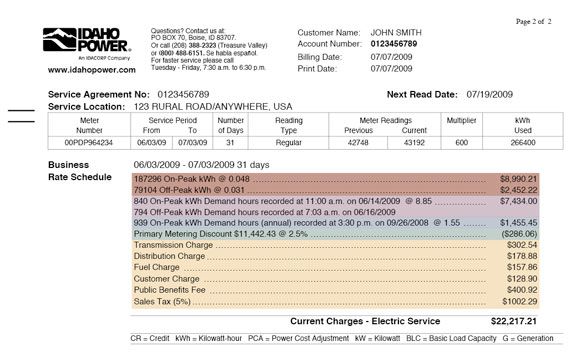Shuffling through the mail on a daily basis is a menial, yet important task that can rarely be described as exciting. Every once and a while, however, an envelope flashes through your hands that grabs your attention: “You may have already won $10 million!” Ummmmm, yeah, right.
But under that promising package is one that quickly brings you back to reality. You wonder aloud: “How much is it going to be this month?” It’s the dreaded and often unpredictable electric bill.
Like most people, you likely look at the bottom line and cut a check, as it’s much easier than interpreting the matrix of numbers and industry acronyms most people believe are used to confuse them.
But as energy costs continue to rise, understanding your electric bill is vital to make sure you’re being charged the correct rates, at the right time to strategically control your electric consumption and costs.
While most residential customers pay a flat rate for their electricity, commercial, industrial and agricultural facilities pay different rates based on the time of day and, in some cases, the time of year. Traditionally, electricity is most in demand in the mid-afternoon during summer months, when air-conditioners are operating along with industry and manufacturing processes.
To accommodate these demands, utilities are forced to build oversized power plants, creating a great deal of capacity that is seldom used to its full potential.

There are typically five sections to an energy bill: energy charges , demand charges , annual demand charges , primary metering discount and other charges .
The energy charges section details the power consumed between meter readings and the amount of kilowatt-hours used on- and off-peak, of which there are different rates.
The demand charges section documents the day and time of the customer’s highest point of consumption, and how many kilowatts were being consumed at that moment. This section lists the charges associated with this peak charge.
The annual demand charge specifies the customer’s highest demand during the past 12 months and then charges the user for that peak.
Some customers receive a primary metering discount , which helps reduce your costs. The discount comes for customers in which the meters are installed ahead of the transformers. Because transformers are 97 percent to 98 percent efficient, customers actually receive 2 percent to 3 percent less electricity than the meter indicates; therefore they are compensated with a discount to offset those costs.
The other charges section of a typical electric utility bill varies widely among utilities. Each utility has its own terminology for the variety of fees they add on to your bill such as customer charge, transmission charge, fuel charge, public benefits fees, and so on.
When making informed energy decisions, it is helpful to know how much, on average, you are paying for electricity. Use simple math to figure out your blended rate.
The blended rate is calculated by dividing the amount of your bill by the total kilowatt-hours consumed. For example, if your bill is $22,217.22, and you consumed 266,400 kilowatt-hours, your blended rate is 8.3 cents per kilowatt-hour.
To get a true blended rate, calculate your blended rate over several months, which will help you reveal any seasonal highs and lows and provide an accurate snapshot of your average power costs.
We use the blended rate to calculate return on investment, proving to dairies that energy-efficient technology is also cost-efficient.
So how can this help you save money?
Well, first, examine your electric bill, and understand the charges. Visit your utility provider’s website to learn more about your bill and how they charge you for energy. Many utilities have multiple plans; be sure your plan best suits you and your dairy operations.
And as always, consider ways to reduce your energy use. Switch to energy-efficient motors, energy-saving lighting, improved HVAC controls and more. Armed with your blended rate, you can determine your return on investment for energy savings to ensure that proposed projects are worth the expense.
Furthermore, knowing that electricity on-peak during the day is more expensive, consider measures that take advantage of overnight electricity that’s often significantly less expensive.
When it’s all said and done, just remember, “You may have already won $10 million,” in which case, you won’t have to worry about any of this. Of course, until then, you’ll have to decipher the electric bill like the rest of us to make informed decisions about your energy use. PD

-
Mike Ontrop
- National Sales Manager
- Agricultural Division
- Email Mike Ontrop





